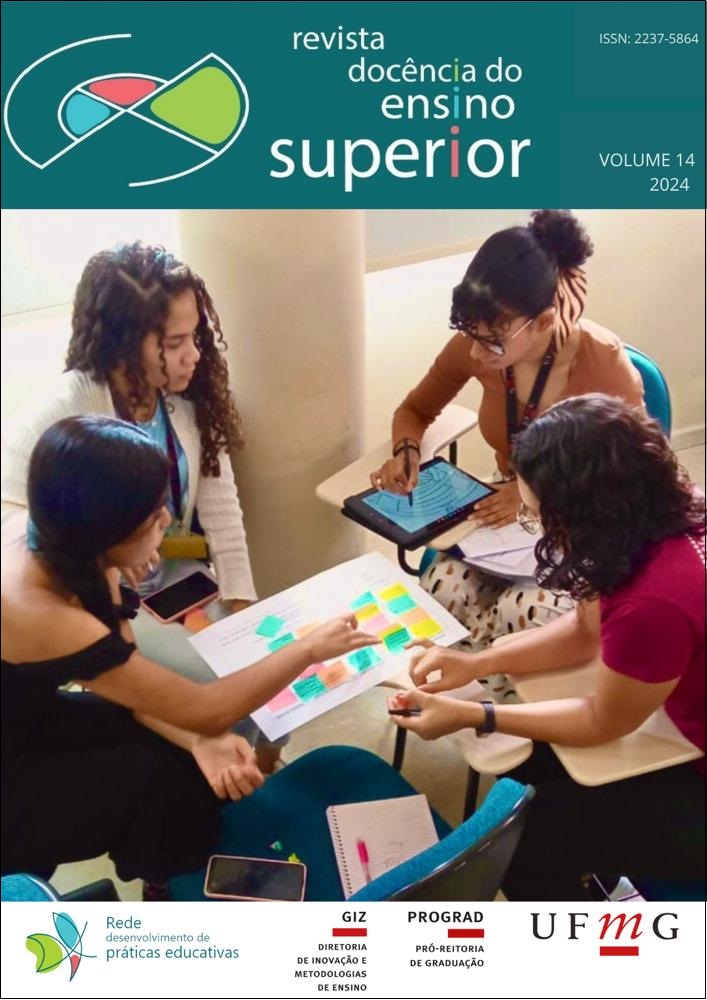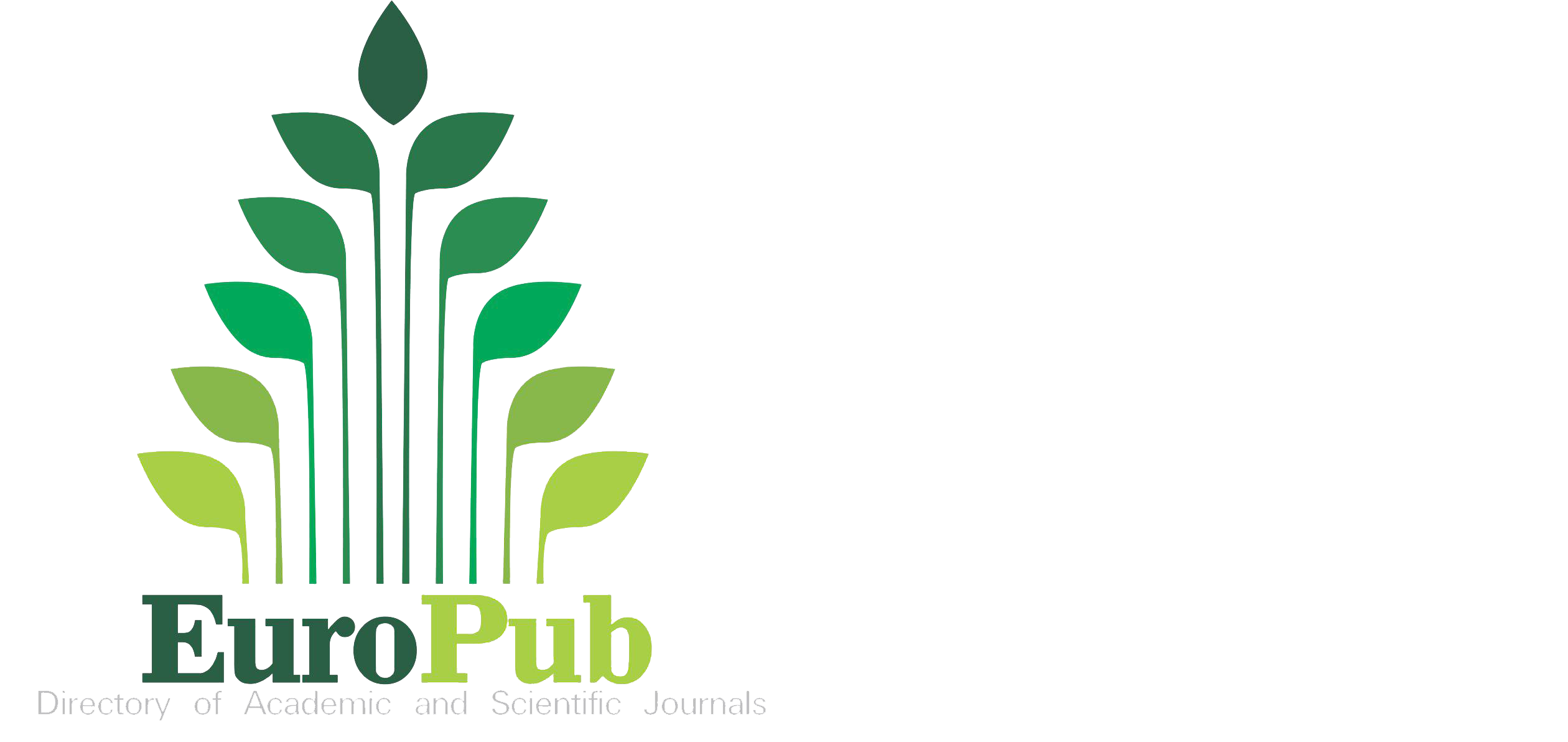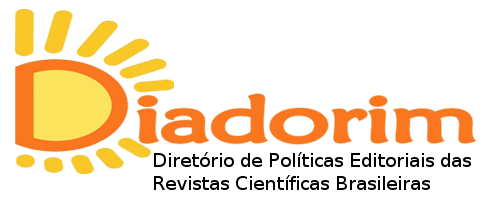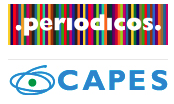Análise das crenças de autoeficácia de tutores da educação a distância
DOI:
https://doi.org/10.35699/2237-5864.2024.48507Palavras-chave:
autoeficácia, tutores on-line, ensino superior, educação a distânciaResumo
Esta pesquisa teve por objetivo avaliar a autoeficácia e as fontes de formação das crenças de autoeficácia de professores que atuam como mediadores on-line de um curso superior de tecnologia em Gestão Empresarial, oferecido na modalidade a distância, por uma faculdade tecnológica estadual. Foi realizado um estudo correlacional sobre a autoeficácia docente na educação a distância. Trata-se de um estudo de abordagem quantitativa na modalidade de pesquisa exploratória. Foram utilizados três instrumentos de coleta de dados: questionário sociodemográfico, escala de autoeficácia do professor e escala sobre fontes de autoeficácia. A coleta de dados ocorreu de forma on-line. Os dados obtidos foram submetidos às análises estatísticas descritivas (frequências, percentuais, escores médios e desvio padrão); análises associativas/correlacionais de Pearson, a fim de identificar possíveis correlações entre autoeficácia docente e fontes de formação de crenças de autoeficácia. Os resultados apresentados levaram à conclusão de que os docentes participantes da pesquisa possuem crenças de autoeficácia elevadas, independentemente da área de formação, titulação ou experiência. Porém, também foi apontado que essas crenças têm pouca influência das fontes das crenças de autoeficácia – experiência direta; experiência vicária; persuasão social; estados fisiológicos e afetivos –, visto que, na estatística correlacional, apresentaram correlação moderada ou baixa, o que indica pouca influência na construção dessas crenças para esses participantes. Dentre essas fontes, a experiência vicária exerceu maior influência na construção das crenças de autoeficácia dos participantes e os estados fisiológicos e afetivos exerceram a menor influência nessa construção.
Downloads
Referências
ABMES – Associação Brasileira de Mantenedoras de Ensino Superior. Ensino a Distância se consolida na pandemia. 2021. Disponível em: https://abmes.org.br/noticias/detalhe/4317/ensino-a-distancia-se-consolida-na-pandemia. Acesso em: 8 nov. 2021.
ALMEIDA, Helber Rangel Formiga Leite de; BORBA, Marcelo de Carvalho. Interações colaborativas e o papel do aluno na polidocência. Ciências & educação, Bauru, v. 24, n. 2, p. 431-448, 2018. DOI: https://doi.org/10.1590/1516-731320180020011. Disponível em: https://www.scielo.br/j/ciedu/a/RzphPWXyMm7MdGQ5VgtJHTt/?lang=pt. Acesso em: 10 dez. 2021.
ALVES, Lynn; NOVA, Cristiane. Educação a Distância: Uma Nova Concepção de Aprendizagem e Interatividade. São Paulo: Futura, 2003.
BANDURA, Albert. Social foundations of thought and action: a social cognitive theory. New Jersey: Prentice Hall, 1986.
BANDURA, Albert. Self-efficacy: The exercise of control. New York: W. H. Freeman and Company, 1997.
BANDURA, Albert. Social cognitive theory: an agentic perspective. Annual Review of Psychology, v. 52, p. 1-26, 2001. DOI: https://doi.org/10.1146/annurev.psych.52.1.1. Disponível em: https://www.annualreviews.org/content/journals/10.1146/annurev.psych.52.1.1. Acesso em: 10 dez. 2021.
BARROS, Marizeth; BATISTA-DOS-SANTOS, Ana Cristina. Por dentro da autoeficácia: um estudo sobre seus fundamentos teóricos, suas fontes e conceitos correlatos. Revista Espaço Acadêmico, v. 10, n. 112, p. 1-9, 2010.
BELLONI, Maria Luiza. Educação a distância. 5. ed. Campinas, SP: Editores Associados, 2009.
BOPSIN, Gustavo; GUIDOTTI, Charles. Crenças de autoeficácia de estudantes e professores de Física do Ensino Superior. Revista Educar Mais, Pelotas, v. 6, p. 106-125, 2022. DOI: https://doi.org/10.15536/reducarmais.6.2022.2472. Disponível em: https://periodicos.ifsul.edu.br/index.php/educarmais/article/view/2472. Acesso em: 4 set. 2023.
BRASIL. Conselho Nacional de Educação/Câmara de Ensino Superior. Resolução nº 1. Estabelece Diretrizes e Normas Nacionais para a Oferta de Programas e Cursos de Educação Superior na Modalidade a Distância. Diário Oficial [da] República Federativa do Brasil, Poder Executivo, Brasília, DF. 14. mar. 2016. Seção 1, p. 23-24.
BRASIL. Instituto Nacional de Estudos e Pesquisas Educacionais Anísio Teixeira (INEP). Censo da Educação Superior 2021: Notas Estatísticas. Brasília, DF. Inep, 2022.
BRESSA, Rebeca Carvalho; MURGO, Camélia Santina; SENA, Bárbara Cristina Soares. Associations between teacher self-efficacy and the use of Objective Structured Clinical Examination in medical education. Revista Brasileira de Educação Médica v. 45, n. 1, 2021. DOI: https://doi.org/10.1590/1981-5271v45.1-20200130.ING. Disponível em: https://www.scielo.br/j/rbem/a/Ph8M7hJmk4BVZ6Bz5cPs4ys/?lang=en#. Acesso em: 10 dez. 2021.
CALSIN, Ingrid Weber; HEIDEMANN, Leonardo Albuquerque. Um estudo sobre a influência de um programa de na motivação para a persistência de licenciandos em física durante o ensino remoto emergencial. Ensaio Pesquisa em Educação e Ciências, Belo Horizonte, n. 25, 2023. DOI: https://doi.org/10.1590/1983-21172022240135. Disponível em: https://www.scielo.br/j/epec/a/ztxQKVmJqbsLBpdhWMwjszs/?lang=pt. Acesso em: 10 dez. 2021.
CARLOTTO, Mary Sandra; DIAS, Sofia Raquel da Silva; BATISTA, Jaqueline Brito Vidal; DIEHL, Liciane. O papel mediador da autoeficácia na relação entre a sobrecarga de trabalho e a dimensão de Burnout em professores. Psico-USF, v. 20, n. 1, p. 13-23, 2015. DOI: https://doi.org/10.1590/1413-82712015200102. Disponível em: https://www.scielo.br/j/pusf/a/vshqHYK7xgXRkMtxJ7DDPYL/?lang=pt. Acesso em: 8 out. 2024.
COMITÊ DE ÉTICA EM PESQUISA DA UNOESTE (Universidade do Oeste Paulista). Protocolo de aprovação de pesquisa. Protocolo nº 57810222.1.0000.5515, 10 mai. 2022.
COSTA FILHO, José de Oliveira; MURGO, Camélia Santina; FRANCO, Aline Fonseca. Autoeficácia na educação médica: uma revisão sistemática da literatura. Educação em revista, Belo Horizonte, v. 38, 2022. DOI: https://doi.org/10.1590/0102-469835900. Disponível em: https://www.scielo.br/j/edur/a/w8Txhd39ghJvNqfNXf9dCFb/abstract/?lang=pt. Acesso em: 8 nov. 2021.
FIELD, Andy. Discovering statistics using R. SAGE Publications, 2012.
FORCINITTI, Caio Raphael Vanoni. O impacto da pandemia nas disciplinas experimentais de Química: análise de crenças de autoeficácia. Trabalho de Conclusão de Curso (Graduação em Química) – Centro de Ciências Físicas e Matemáticas, Universidade Federal de Santa Catarina, Santa Catarina, 2022.
HAUKOOS, Jason S.; LEWIS, Roger J. Advanced statistics: bootstrapping confidence intervals for statistics with "difficult" distributions. Academic Emergency Medicine, v. 12, n. 4, p. 360-365. 2005. DOI: https://doi.org/10.1197/j.aem.2004.11.018. Disponível em: https://onlinelibrary.wiley.com/doi/10.1197/j.aem.2004.11.018. Acesso em: 4 set. 2021.
IAOCHITE, Roberto Tadeu. Auto-eficácia de docentes de educação física. 2007. Tese (Doutorado em Educação) – Faculdade de Educação, Universidade Estadual de Campinas, Campinas, 2007.
IAOCHITE, Roberto Tadeu; AZZI, Roberta Gurgel; POLYDORO, Soely Aparecida Jorge; WINTERSTEIN, Pedro José. Autoeficácia docente, satisfação e disposição para continuar na docência por professores de educação física. Revista Brasileira de Ciências do Esporte, Brasília, Florianópolis, v. 33, n. 4, p. 825-839, out./dez. 2011. DOI: https://doi.org/10.1590/S0101-32892011000400003. Disponível em: https://www.scielo.br/j/rbce/a/VzfLsJXxSkQLFmhJK3qCnVb/?lang=pt#. Acesso em: 4 out. 2021.
IAOCHITE, Roberto Tadeu; AZZI, Roberta Gurgel. Escala de fontes de autoeficácia docente: Estudo exploratório com professores de Educação Física. Psicologia Argumento, Curitiba, v. 30, n. 71, 2012. DOI: https://doi.org/10.7213/psicol.argum.7472. Disponível em: https://periodicos.pucpr.br/psicologiaargumento/article/view/20345. Acesso em: 4 set. 2021.
KUHN, Filipy; ANDRADE, Alexandro; DUEK, Viviane Preichardt; BACKES, Ana Flávia; COSTA, Matheus da Lapa; RAMOS, Valmor. Contribution of a physical education undergraduate program in the teaching self-efficacy beliefs. Journal of Physical Education, v. 31, n. 1, p. e-3147, 17 jun. 2020. DOI: https://doi.org/10.4025/jphyseduc.v31i1.3147. Disponível em: https://www.scielo.br/j/jpe/a/qpXvXHqRTqbDpQLFbssb5Ww/. Acesso em: 4 set. 2021.
LENHARD, Wolfgang; LENHARD, Alexandra. Computation of Effect Sizes. 2017. DOI: https://doi.org/10.13140/RG.2.2.17823.92329. Disponível em: https://www.psychometrica.de/effect_size.html. Acesso em: 4 set. 2021.
MARTINS, Bárbara Amaral; CHACON, Miguel Claudio Moriel. Estar presente é estar incluído? Análise de situações em que a inclusão escolar não acontece. Revista Ibero-Americana de Estudos em Educação, v. 17, n. 2, p. 1339-1355, 2022. DOI: https://doi.org/10.21723/riaee.v17iesp.2.17001. Disponível em: https://periodicos.fclar.unesp.br/iberoamericana/article/view/17001. Acesso em: 4 set. 2023.
MASLACH, Christina; JACKSON, Susan E. Maslach burnout inventory: the measurement of experienced burnout. Journal of Ocuppational Behavior, v. 2, n. 1, p. 99-113, 1981. DOI: https://doi.org/10.1002/job.4030020205. Disponível em: https://onlinelibrary.wiley.com/doi/10.1002/job.4030020205. Acesso em: 4 set. 2023.
MATTAR, João; RODRIGUES, Lucilene Marques Martins; CZESZAK, Wanderlucy; GRACIANI, Juliana. Competências e funções dos tutores online em educação a distância. Educação em revista, v. 36, p. e21743, 2020. DOI: https://doi.org/10.1590/0102-4698217439. Disponível em: https://www.scielo.br/j/edur/a/wDMtcL9SsDw5ZMFLfxr98Cw/?lang=pt#. Acesso em: 10 dez. 2021.
MILL, Daniel. Sobre o conceito de polidocência ou sobre a natureza do processo de trabalho pedagógico na Educação a Distância. In: MILL, D. R. S.; RIBEIRO, L. R. de C.; OLIVEIRA, M. R. G. de (org). Polidocência na educação a distância: múltiplos enfoques. São Carlos, SP: EdUFSCar, 2010, p. 23-40.
NUNES, Maiana Farias Oliveira. Funcionamento e desenvolvimento das crenças de auto-eficácia: uma revisão. Revista Brasileira de Orientação Profissional, Campinas, v. 9, n. 1, p.29-42, 2008. Disponível em: https://pepsic.bvsalud.org/scielo.php?script=sci_arttext&pid=S1679-33902008000100004. Acesso em: 15 dez. 2021.
NUNES, Andrea Karla Ferreira; OLIVEIRA, Alice Virginia Brito de; SABINO, Rosimeri Ferraz. Docência na educação a distância: abordagem sobre o perfil profissional. Revista Internacional de Educação Superior, Campinas, SP, v. 5, p. e019009, 2019. DOI: https://doi.org/10.20396/riesup.v5i0.8653379. Disponível em: https://periodicos.sbu.unicamp.br/ojs/index.php/riesup/article/view/8653379. Acesso em: 10 dez. 2021.
POLYDORO, Soely Aparecida Jorge; WINSTERSTEIN, Pedro José; AZZI, Roberta Gurgel; CARMO, Ana Paula do; VENDITTI JÚNIOR, Rubens. Escala de auto-eficácia do professor de Educação Física. In: MACHADO, C.; ALMEIDA, L. S.; GONÇALVES, M.; RAMALHO (org.). Avaliação Psicológica: formas e contextos. Braga: Psiquilíbrios edições, 2004, p. 330-337.
PRIETO NAVARRO, Leonor. Autoeficácia del profesor universitario. Eficacia percibida y práctica docente. 2. ed. Madrid: Narcea S. A. Ediciones, 2009.
R DEVELOPMENT CORE TEAM. A language and environment for statistical computing. 2010. Disponível em: https://www.r-project.org/.
SALLES, William das Neves; FOLLE, Alexandra; FARIAS, Gelcemar Oliveira; NASCIMENTO, Juarez Vieira do. Teaching self-efficacy and factor associated with the teaching practice of physical education. Journal of Physical Education, Maringá, v. 31, 2020. DOI: https://doi.org/10.4025/jphyseduc.v31i1.3116. Disponível em: https://www.scielo.br/j/jpe/a/C8VShsrs3bsMP8kJ4VPDhvH/?lang=en#. Acesso em: 2 set. 2023.
SANTOS, Acácia Aparecida Angeli dos; INÁCIO, Amanda Lays Monteiro. Mensuração de crenças de autoeficácia docente: revisão de literatura. Interação em Psicologia, Curitiba, v. 25, n. 03, 2021. DOI: http://dx.doi.org/10.5380/riep.v25i3.68816. Disponível em: https://revistas.ufpr.br/psicologia/article/view/68816. Acesso em: 30 ago. 2023.
SANTOS, Sandra Regina Costa dos; STROHSCHOEN, Andreia Aparecida Guimarães. O papel docente na EaD: novas perspectivas para o trabalho pedagógico. Research, Society and Development, v. 9, n. 6, 2020. DOI: https://doi.org/10.33448/rsd-v9i6.3724. Disponível em: https://rsdjournal.org/index.php/rsd/article/view/3724. Acesso em: 20 ago. 2023.
SILVA, Ana Paula Ribeiro. Sistema de tutoria e modelos de feedback. São Carlos: Editora Pixel, 2017.
SILVA, Ketiuce Ferreira. Resenha do livro Docência virtual: uma visão crítica. Revista Eletrônica de Educação, São Carlos, v. 8, n. 2, 2014. DOI: https://doi.org/10.14244/19827199814. Disponível em: https://www.reveduc.ufscar.br/index.php/reveduc/article/view/814. Acesso em: 4 set. 2021.
SILVA, Rafaela Ferreira da; BARBOSA, Silvânia da Cruz; PATRÍCIO, Danielle Figueiredo; LOPES, Helyssa Luana. Autoeficácia como preditora de burnout em professores do ensino fundamental II. Revista Laborativa, v. 11, n. 2, p. 55-75, 2022. Disponível em: https://ojs.unesp.br/index.php/rlaborativa/article/view/3785. Acesso em: 20 ago. 2023.
SEVERINO, Antônio Joaquim. Metodologia do Trabalho Científico. São Paulo: Cortez, 2007.
TSCHANNEN-MORAN, Megan; HOY, Wayne K. A multidisciplinary analysis of the nature, meaning, and measurement of trust. Review of Educational Research, v. 70, n. 4, 2000. DOI: http://dx.doi.org/10.2307/1170781. Disponível em: https://www.researchgate.net/publication/249797852_A_Multidisciplinary_Analysis_of_the_Nature_Meaning_and_Measurement_of_Trust. Acesso em: 20 ago. 2023.
VELOSO, Braian Garrito; MILL, Daniel; MONTEIRO, Maria Iolanda. Docência, educação a distância e tecnologias digitais: um estudo bibliométrico. Revista Eletrônica de Educação, v. 13, n. 1, p. 319-335, jan./abr. 2019. DOI: http://dx.doi.org/10.14244/198271992167. Disponível em: https://www.reveduc.ufscar.br/index.php/reveduc/article/view/2167. Acesso em: 10 dez. 2021.
VENDITTI JÚNIOR, Rubens. Análise da auto-eficácia docente de professores de educação física. 2005. 167 f. Dissertação (Mestrado em Educação Física). Faculdade de Educação Física, Campinas: Universidade Estadual de Campinas, 2005.
VIEIRA-SANTOS, Joene. O desenvolvimento de habilidades sociais em EaD: o papel do feedback do tutor. Psicologia Escolar e Educacional, São Paulo, v. 24, 2020. DOI: https://doi.org/10.1590/2175-35392020217008. Disponível em: https://www.scielo.br/j/pee/a/Jvf4dnSzpQ9BCvPhsHLwnPy/?lang=pt. Acesso em: 30 ago. 2023.
WOOLFOLK HOY, Anitta; BURKE SPERO, Rhonda. Changes in teacher efficacy during the early years of teaching: A comparison of four measures. Teaching and Teacher Education, v. 21, n. 4, 2005. DOI: https://doi.org/10.1016/j.tate.2005.01.007. Disponível em: https://www.sciencedirect.com/science/article/abs/pii/S0742051X05000193?via%3Dihub. Acesso em: 10 dez. 2021.
Publicado
Edição
Seção
Licença
Copyright (c) 2024 Raquel Tiemi Masuda Mareco, Camélia Santina Murgo

Este trabalho está licenciado sob uma licença Creative Commons Attribution 4.0 International License.
Autores que publicam nesta revista mantêm os direitos autorais e concedem à revista o direito de primeira publicação, com o trabalho simultaneamente licenciado sob a Licença Creative Commons Attribution que permite o compartilhamento do trabalho com reconhecimento da autoria e publicação inicial nesta revista.
Autores têm autorização para assumir contratos adicionais separadamente, para distribuição não-exclusiva da versão do trabalho publicada nesta revista (ex.: publicar em repositório institucional ou como capítulo de livro), com reconhecimento de autoria e publicação inicial nesta revista.
Política de acesso aberto:
A Revista Docência do Ensino Superior é um periódico de Acesso Aberto, o que significa que todo o conteúdo está disponível gratuitamente, sem custo para o usuário ou sua instituição. Os usuários podem ler, baixar, copiar, distribuir, imprimir, pesquisar ou vincular os textos completos dos artigos, ou usá-los para qualquer outra finalidade legal, sem solicitar permissão prévia do editor ou do autor, desde que respeitem a licença de uso do Creative Commons utilizada pelo periódico. Esta definição de acesso aberto está de acordo com a Iniciativa de Acesso Aberto de Budapeste (BOAI).



























